Diplomatic Bluebook 2024
Chapter 3
Diplomacy to Defend National Interests through Co-creation with the World
2 Japan-U.S. Security Arrangements
(1) Overview of Japan-U.S. Security Relationship
Under the security environment surrounding Japan, which is becoming increasingly severe at an ever more rapid pace, it is indispensable to strengthen the Japan-U.S. Security Arrangements and to enhance the deterrence and response capabilities of the Japan-U.S. Alliance not only for the peace and security of Japan, but also for the peace and stability of the Indo-Pacific region. Japan and the U.S. are further enhancing their deterrence and response capabilities under the Guidelines for Japan-U.S. Defense Cooperation (“The Guidelines”) and the Legislation for Peace and Security. Through such efforts, Japan and the U.S. have been expanding and strengthening cooperation in a wide range of areas, including missile defense, cyberspace, space and information security. While advancing these efforts, Japan and the U.S. have concurrently been working closely on the realignment of U.S. Forces in Japan, including the relocation of Marine Corps Air Station (MCAS) Futenma and of approximately 9,000 U.S. Marine Corps in Okinawa to Guam and other locations in order to mitigate the impact on local communities, including Okinawa.
(2) Japan-U.S. Security and Defense Cooperation in Various Fields
A An Overview of Japan-U.S. Security and Defense Cooperation
The Guidelines for Japan-U.S. Defense Cooperation, which were formulated in 2015, reviewed and updated the general framework and policy direction of Japan-U.S. defense cooperation. Through the Alliance Coordination Mechanism (ACM) and other efforts established under these Guidelines, Japan and the U.S. have been sharing information closely, establishing a common understanding of the situation, and engaging in “seamless” responses and efforts from peacetime to contingencies. From its inauguration till now, the Biden administration has consistently made it clear that it places great importance on the Japan- U.S. Alliance.
In January, the Japan-U.S. Security Consultative Committee (Japan-U.S. “2+2”) was convened in Washington, D.C. (U.S.) in a timely manner, immediately after the release of strategic documents by the two countries. The meeting was attended by Foreign Minister Hayashi and Defense Minister HAMADA Yasukazu from the Japanese side, and Secretary of State Antony Blinken and Secretary of Defense Lloyd Austin from the U.S. side. The two sides welcomed the release of their respective National Security Strategies and National Defense Strategies, and confirmed unprecedented alignment of their vision, priorities, and goals, and discussed measures to maximize Alliance deterrence and response capabilities under their strategies. On top of that, in the Japan-U.S. Summit Meeting held in the same month, President Joseph Biden reiterated his unwavering commitment to the defense of Japan. The two leaders also welcomed the national security strategies of the two countries are aligned with each other and renewed their determination to further strengthen the deterrence and response capabilities of the Japan-U.S. Alliance, including seeking to create synergies in the implementation of the strategies. In addition, they instructed to further deepen concrete consultations regarding Japan-U.S. cooperation on the security front, taking into account the discussions at the Japan-U.S. “2+2.”
At the Japan-U.S. Summit Meeting held in May, the two leaders reaffirmed the critical role that U.S. extended deterrence1 plays in ensuring the security of Japan as well as the peace and stability of the region, coupled with Japan's enhanced defense capabilities. President Biden reiterated the U.S. commitment to the defense of Japan under the Treaty of Mutual Cooperation and Security, backed by the full range of capabilities, including nuclear, and, in this context, the two leaders reaffirmed their intent to ensure full bilateral coordination throughout every phase of a developing situation. The two leaders then commended the robust and in-depth consultations on U.S. extended deterrence at the latest Japan-U.S. “2+2” and Extended Deterrence Dialogue (EDD) meetings, and reaffirmed the importance of further strengthening such consultations (See the Special Feature on page 197).
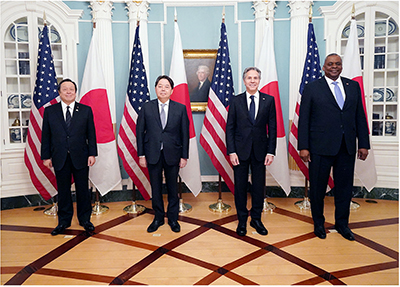
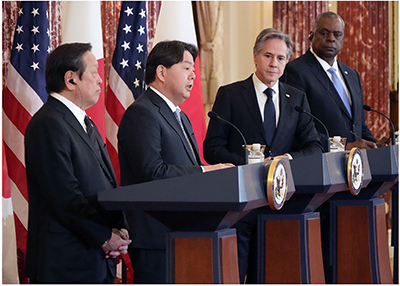 Japan-U.S. “2+2” (January 11, Washington, D.C., U.S.)
Japan-U.S. “2+2” (January 11, Washington, D.C., U.S.)In 2023, Japan continued to engage in personnel exchanges with senior U.S. defense officials, including successive visits to Japan by Admiral James F. Caldwell Jr., Director of Naval Reactors in April; David H. Berger, Commandant of the U.S. Marine Corps in May; Secretary of Defense Austin in June; Michael M Gilday, Chief of Naval Operations in July; General Anthony J. Cotton, Commander of U.S. Strategic Command (STRATCOM), General Eric M. Smith, Assistant Commandant of the U.S. Marine Corps, and Admiral John C. Aquilino, Commander, U.S. Indo-Pacific Command in September; General Charles Q. Brown, Chairman of the Joint Chiefs of Staff of the U.S. in November; and General Charles A. Flynn, Commanding General, U.S. Army, Pacific and Jacqueline D. Van Ovost, Commander, U.S. Transportation Command in December. In August, there was also a visit to Japan by Representative Robert Wittman, U.S. Congressman, and his delegation.
In accordance with the Japan-U.S. Summit Meeting held in May, discussions within the EDD on extended deterrence were further intensified. The EDD was established in 2010, and as a part of Japan-U.S. security and defense cooperation, it provides an opportunity for the two governments to discuss regional security, Alliance defense posture, nuclear and missile defense policy, and arms control issues, to engage in an in-depth exchange of views on means to sustain and strengthen extended deterrence, which is at the core of the Japan-U.S. Alliance and to deepen mutual understanding on alliance deterrence. At the EDD meeting held at Whiteman Air Force Base in Missouri in June, the U.S. side reiterated its commitment to increase the visibility of U.S. strategic assets in the region. The two sides also concurred to continue to explore avenues to deepen Alliance cooperation through improved information sharing, training, and exercises, including the use of table-top exercises, to further prepare the Alliance to defend against potential attacks and deter nuclear employment. Both sides also pledged to improve coordination and strengthen the Alliance's capabilities and posture to adversary missile threats. As a part of the meeting, the delegations experienced a B-2 flight simulator, and toured a B-2 strategic bomber and decommissioned Minuteman II launch control center. At the EDD meeting hosted by Japan in December, the two sides shared assessments of the regional security environment, and reviewed Alliance conventional and U.S. nuclear capabilities contributing to regional deterrence and highlighted the importance of optimizing the Alliance's force posture and activities to bolster deterrence effectiveness. They also discussed strategic arms control and risk reduction approaches in response to nuclear risks that are becoming increasingly challenging and complex as diversification and expansion of regional actors' nuclear arsenals are advancing. In addition, the delegations visited the JGSDF's Amphibious Rapid Deployment Brigade in Camp Ainoura and Sakibe, which plays an important role in defense and deterrence of the Southwestern Islands of Japan. In both the meetings held in June and December, agencies from both sides conducted table-top exercises, which have regularly been included in the EDD meeting agenda to discuss ways to coordinate Alliance deterrence efforts. Through such multilayered initiatives, Japan will continue to promote security and defense cooperation with the U.S., and to further strengthen the deterrence and response capabilities of the Alliance.
- 1 Providing deterrence that a country possesses to its allies and partners.
In the vicinity of Japan, military buildups, including of nuclear weapons and missiles, are rapidly advancing, coupled with mounting pressures by unilaterally changing the status quo by force. North Korea intends to bolster its nuclear capabilities both in quality and in quantity at the maximum speed, and is rapidly developing its missile-related technologies. Russia continues to repeat words and actions that could be interpreted as threats of use of nuclear weapons in the context of its aggression against Ukraine, and further, has suspended the implementation of the Treaty between the United States of America and the Russian Federation on Measures for the Further Reduction and Limitation of Strategic Offensive Arms (New START Treaty) alongside other actions that go against arms control efforts to date. China has been extensively and rapidly enhancing its military power, including its nuclear and missile capabilities, without sufficient transparency. There are also movements toward cooperation between China and Russia, and between Russia and North Korea respectively. Amid this severe security environment, Japan is advocating a policy of further strengthening deterrence and response capabilities of the Japan-U.S. Alliance including U.S. extended deterrence in its National Security Strategy (NSS) and other documents, in order to ensure the security of Japan.
“Deterrence” is comprehended as serving the function of discouraging aggression by making the other party clearly aware that it would suffer intolerable damage if it were to commit aggression, or recognize clearly that our side has the ability to physically deny attack by the aggressor. Accordingly, “extended deterrence” generally refers to extending the deterrence of a certain country to its allies and partners. In this regard, Japan is provided with extended deterrence by its ally, the U.S.
“Deterrence capabilities” constitute not only nuclear, but also include response capabilities based on conventional forces. Using only conventional forces, it is difficult to deter an actor that is threatening to use nuclear weapons; in such cases, it is necessary to deter that actor with nuclear capabilities. However, Japan is a State Party to the Treaty on the Non-Proliferation of Nuclear Weapons (NPT), upholds the Three Non-Nuclear Principles, and will therefore not possess any nuclear weapons on its own. Under such a premise, and in the face of the reality of security threats to Japan, such as those of nuclear weapons, U.S. extended deterrence, including through nuclear weapons, is indispensable.
The U.S. has, on many occasions, affirmed its commitment to defend Japan under the Japan-U.S. Security Treaty, and to extend deterrence to Japan through a full range of capabilities, including nuclear.
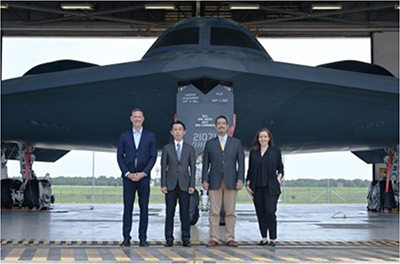 Tour of B-2 strategic bombers during the Japan-U.S. Extended Deterrence Dialogue (June, Whiteman Air Force Base, Missouri, U.S.; Photo: U.S. Department of Defense)
Tour of B-2 strategic bombers during the Japan-U.S. Extended Deterrence Dialogue (June, Whiteman Air Force Base, Missouri, U.S.; Photo: U.S. Department of Defense)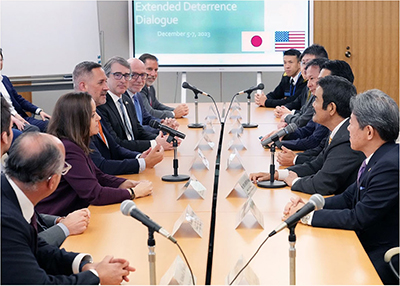 Discussions at the Japan-U.S. Extended Deterrence Dialogue (December, Japan)
Discussions at the Japan-U.S. Extended Deterrence Dialogue (December, Japan)Japan and the U.S. have also engaged in the close exchange of wide-ranging views on a regular basis on various matters related to the deterrence policies of the Japan-U.S. Alliance. In particular, in the working-level Japan-U.S. Extended Deterrence Dialogue that has been held on a regular basis since 2010, Japan and the U.S. hold in-depth discussions on extended deterrence and consult on measures to further enhance relevant bilateral cooperation. In 2023, the two governments engaged in extensive discussions in the U.S. in June and in Japan in December, including through table-top exercises. On each occasion, the respective delegations had the opportunity to observe important troops and defense equipment for deterrence, such as B-2 strategic bombers in the U.S. and the Japan Ground Self-Defense Force's Amphibious Rapid Deployment Brigade in Sasebo, Japan.
Furthermore, in May 2022, Prime Minister Kishida and President Biden emphasized the further strengthening of U.S. extended deterrence, and concurred on communicating more closely between the two countries including at the ministerial level. In light of this, at the Japan-U.S. Security Consultative Committee (Japan-U.S. “2+2”) held in January 2023, Japan and the U.S. took time to have in-depth discussions on extended deterrence as one of the agenda items. In this way, the Japan-U.S. Alliance is steadily deepening in the aspect of extended deterrence as well. Going forward, Japan will continue to further strengthen bilateral dialogues at various levels, and to further enhance relevant concrete cooperation, with a view to maintaining and strengthening U.S. extended deterrence.
B Missile Defense
Japan has been making steady efforts to develop and engage in the production of the Ballistic Missile Defense (BMD) system while continuing cooperation with the U.S., including on the steady implementation of joint development and joint production of the Standard Missile 3 (SM-3 Block IIA) since 2006, and Japan is fully prepared to protect the lives and property of its citizens from the threat of ballistic missiles to Japan under any circumstances. Japan is also advancing efforts to effectively address new aerial threats, including hypersonic weapons. At the Japan-U.S. “2+2” held in January, based on the progress of joint analysis on counter-hypersonic technology, the Ministers concurred to begin joint research on important elements including advanced materials and hypersonic testbeds, and also concurred to begin discussion on potential joint development of a future interceptor. Based on this, the two countries conducted a review and consequently announced during the Japan-U.S. Summit Meeting in August that they have decided to initiate the joint development of Glide Phase Interceptors (GPI).
C Cyberspace
At the Japan-U.S. “2+2” meeting convened in January, Japan and the U.S. concurred to intensify collaboration to counter increasingly sophisticated and persistent cyber threats. In light of the outcomes of the Japan-U.S. “2+2” meeting and the necessity for cross-governmental efforts by both Japan and the U.S., the 8th Japan-U.S. Cyber Dialogue was convened in May, where participants held discussions on a wide range of issues regarding Japan-U.S. cooperation on cyber-related matters, including cyber policies in both countries, cooperation in international areas and bilateral cooperation. Stakeholders from both sides engage in discussions, through frameworks such as the Japan-U.S. Cyber Dialogue, on bilateral cooperation across a wide range of areas. Furthermore, the two sides are continuing to cooperate on matters related to cyberspace, including promoting bilateral policy coordination, strengthening systems and capabilities, and exchanging incident information, while taking into consideration Japan's cyber security strategy and the cyber policies of the U.S.
D Space
At the Japan-U.S. “2+2” convened in January, Japan and the U.S. committed to deepening cooperation on space capabilities, and considered that attacks to, from, or within space, present a clear challenge to the security of the Alliance, and affirmed such attacks, in certain circumstances, could lead to the invocation of Article V of the Japan-U.S. Security Treaty. Japan and the U.S. are continuing to cooperate on space security, including through mutual exchanges of information in the field of Space Situational Awareness and others, as well as cooperation on hosted payloads (mission instruments loaded onto other entities' satellites).
E Information Security
Information security plays a crucial role in advancing cooperation within the context of the Alliance. Based on this perspective, both countries continue to hold discussions designed to enhance their cooperation regarding information security, the importance of which was affirmed at the Japan-U.S. “2+2” held in January.
(3) Realignment of U.S. Forces in Japan
While advancing the efforts described above, the Government of Japan will continue to make every effort to mitigate the impact on local communities, including Okinawa, and to maintain the stable presence of U.S. Forces in Japan, by steadily implementing the realignment of U.S. Forces in Japan, including the relocation of MCAS Futenma to Henoko.
In the Joint Statement of the Security Consultative Committee (“2+2”) released in January, the two sides confirmed the importance of accelerating bilateral work on these force realignment efforts. In the Statement, Japan and the U.S. affirmed the need to optimize the Alliance force posture based on the improved operational concepts and enhanced capabilities, including the defense of the Southwestern Islands of Japan. They also confirmed that the forward posture of U.S. Forces in Japan should be upgraded to strengthen Alliance deterrence and response capabilities by positioning more versatile, resilient, and mobile forces with increased intelligence, surveillance, and reconnaissance, anti-ship, and transportation capabilities. In line with such policy, Japan and the U.S. affirmed that the Japan-U.S. Roadmap for Realignment Implementation, as adjusted at the Japan-U.S. “2+2” in April 2012, will be readjusted so that the 3rd Marine Division Headquarters and the 12th Marine Regiment will remain in Okinawa and the 12th Marine Regiment will be reorganized into the 12th Marine Littoral Regiment by 2025. This effort will be carried out while maintaining the basic tenets of the 2012 Realignment Plan, with utmost consideration to the impacts on local communities. Japan and the U.S. also confirmed the importance of accelerating bilateral work on U.S. Force realignment efforts, including construction of relocation facilities and land returns in Okinawa, and the relocation of Marine Corps personnel from Okinawa to Guam beginning in 2024.
In particular, the return of lands in Okinawa has been realized by completing various return projects based on the April 2013 “Consolidation Plan for Facilities and Areas in Okinawa,” even after the return of a major portion of the Northern Training Area (NTA, approximately 4,000 hectares) in December 2017. The return of all areas indicated as “Immediate Return” under the Consolidation Plan was achieved with the return of a portion of the Facilities and Engineering Compound in Camp Zukeran in March 2020. The land near Samashita Gate at Futenma Air Station was also returned in December 2020, followed by the return of the laundry factory area of Makiminato Service Area (land along National Route No. 58) in May 2021. In May 2022, which marked the 50th anniversary of the reversion of Okinawa to Japan, Japan and the U.S. concurred to enable the public use of the Lower Plaza Housing Area of Camp Zukeran as a greenspace, ahead of its return to Japan, and the start of general use commenced in March 2024.
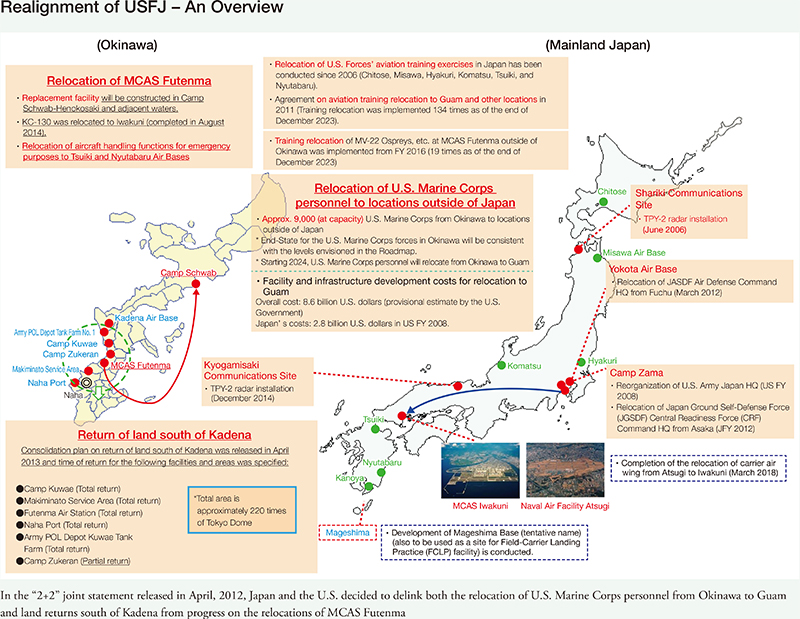
(4) Host Nation Support (HNS)
With a view to ensuring the effective operations of U.S. Forces in Japan amidst the growing severity of the security situation surrounding Japan, Japan bears a part of costs, such as the costs of Facility Improvement Programs (FIP), within the scope provided for under the Status of Forces Agreement (SOFA). In addition, Japan has also borne the labor costs for U.S. Forces working in Japan, utilities costs, and training relocation costs, by concluding the Special Measures Agreements (SMAs) which set out special measures relating to the SOFA. Under the New SMA signed on January 7, 2022, and entered into force on April 1, it was decided that Japan will also bear the expenditures related to the procurement of training equipment and materials which will contribute, not only to the readiness of U.S. Forces in Japan but also to the enhancement of the interoperability between the Japan Self-Defense Forces (JSDF) and the U.S. Forces. Based on the SOFA and the New SMA, the Government of Japan will bear the HNS costs from FY2022 to FY2026. In consultations on the New SMAs, as both parties concurred that the costs borne by Japan should be used to build a foundation upon which the Japan-U.S. Alliance will be further strengthened, the Japanese side decided to refer to this budget by a Japanese phrase that points to its goal of enhancing Alliance readiness and resiliency. During the effective period of the new SMAs (April 1, 2022 to March 31, 2027), the annual average budget for HNS is approximately 211 billion Japanese yen.
(5) Various Issues Related to the Presence of the U.S. Forces in Japan
To ensure the smooth and effective operation of the Japan-U.S. security arrangements and the stable stationing of U.S. Forces in Japan as the linchpin of these arrangements, it is important to mitigate the impact of U.S. Forces' activities on residents living in the vicinity and to gain their understanding and support regarding the stationing of U.S. Forces. The Government of Japan, in light of the requests from local communities, has been making utmost efforts in areas such as the steadily implementation of the Agreement on Cooperation in the Field of Environmental Stewardship of 2015 and the Agreement on Cooperation with regard to Implementation Practices relating to the Civilian Component of the United States Armed Forces in Japan of 2017, preventing and responding to incidents and accidents involving U.S. Forces, abating the noise by U.S. Forces' aircraft, and dealing with environmental issues at U.S. Forces' facilities and areas. At the Japan-U.S. “2+2” convened in January 2023, Foreign Minister Hayashi requested the U.S. side to strengthen cooperation in matters related to the environment, including per- and polyfluoroalkyl substances (PFAS). As a result, in the Joint Statement of the Japan-U.S. “2+2”, the two sides affirmed that they would enhance environmental cooperation.
Furthermore, the Ministry of Foreign Affairs is implementing various initiatives, including exchanges between U.S. Forces personnel and residents living near U.S. Forces' facilities and areas in Japan.
Since FY2020, the Ministry of Foreign Affairs and the U.S. Department of Defense Education Activity (DoDEA) have been implementing Student Educational Exchange and Dialogue (SEED) projects at the U.S. Forces' facilities and areas in Japan. These projects provide an opportunity for Japanese and American junior high school and high school students to engage in cultural and educational exchanges at schools located within the U.S. Forces' facilities and areas, and have been implemented continuously in various parts of Japan with the cooperation of local governments and U.S. Forces in Japan (See the column on this page).
Particularly in Okinawa, where there is a concentration of U.S. Forces' facilities and areas, the “TOFU: Think of Okinawa's Future in the U.S.” program is implemented to provide an opportunity for high school and university students from Okinawa to witness what Japan's alliance partner, the U.S., is truly like, and the role that Japan plays in the international community, as well as to promote mutual understanding between the two countries. Visits to the U.S. have not been implemented since FY2019 due to the impact of the COVID-19 pandemic, but resumed in FY2022 with 40 participants, twice that of the usual number. The program served as an opportunity for participants to cultivate an international perspective, including visits to Washington, D.C. and New York, exchanges of opinions with key government officials in Tokyo and the respective cities in the U.S., and tours of government facilities.
Since 2020, the Ministry of Foreign Affairs, in cooperation with the U.S. Department of Defense Education Activity (DoDEA), has conducted exchange programs (Student Educational Exchange and Dialogue (SEED) project) for the children of U.S. Forces personnel and local junior and high school students in communities that host U.S. Forces in Japan. By sowing the “SEED” for further cultural and educational exchanges, this program aims to nurture human resources who will take an active role in international society as well as to enhance mutual understanding between Japanese and American junior and senior high school students.
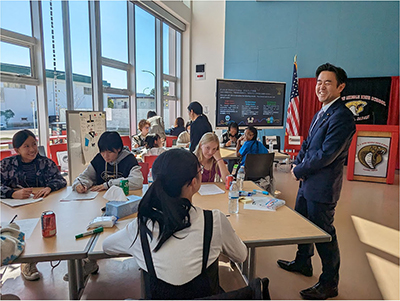 Parliamentary Vice-Minister for Foreign Affairs HOSAKA Yasushi interacting with the participating students (October 22, Sasebo City, Nagasaki Prefecture)
Parliamentary Vice-Minister for Foreign Affairs HOSAKA Yasushi interacting with the participating students (October 22, Sasebo City, Nagasaki Prefecture)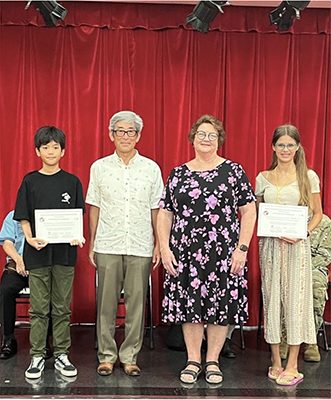 Presentation of completion certificates by Ambassador in charge of Okinawan Affairs, MIYAGAWA Manabu, and DoDEA Pacific South District Superintendent, Dr. Melissa Hayes (October 15, Kadena City, Okinawa Prefecture)
Presentation of completion certificates by Ambassador in charge of Okinawan Affairs, MIYAGAWA Manabu, and DoDEA Pacific South District Superintendent, Dr. Melissa Hayes (October 15, Kadena City, Okinawa Prefecture)In 2023, the program was held at Yokota Air Base (Tokyo), Marine Corps Air Station Iwakuni (Yamaguchi Prefecture), Kadena Air Base (Okinawa Prefecture), U.S. Fleet Activities Sasebo (Nagasaki Prefecture), U.S. Fleet Activities Yokosuka (Kanagawa Prefecture), Camp Zama (Kanagawa Prefecture), and Misawa Air Base (Aomori Prefecture). This column introduces the voices of both Japanese and U.S. students who participated in the program.
●Luke A. Danjanic, EJ King Middle High School
The SEED event provided a fantastic opportunity to interact with my Japanese peers. Unlike formal settings such as school tours or games with strict rules during field trips, this event allowed for a more casual and open exchange. The activities fostered healthy discourse among peers and proved to be an effective bonding technique, though they might have been challenging for some students. The character design activity was my favorite, with each group presenting a unique character symbolizing the friendship between Japan and the U.S. It was fascinating to witness the diverse creations from an eleven-word prompt. Another enjoyable activity involved creating skits based on cultural differences between the U.S. and Japan. One group highlighted the contrasting approaches to ordering at a restaurant. In Japan, you shout out to call the waiter without consequence, while in the U.S., such an act might receive a disapproving look or worse. A highlight of the event was the opportunity to meet the mayor and the head of the Sasebo Board of Education. This encounter further solidified the bond between our two countries. It showcased that youth from both nations are willing to seek common ground to better our future.
●EIYAMA Kanade, Ginowan Municipal Kakazu Junior High School
I participated in the exchange program held at Kadena Air Base in October, with my brother who is one year older. Although I had previously visited the air base with my parents for the annual festival and other events, I had never entered the living areas before, so I was looking forward to it while feeling a little anxious at the same time. I was a little nervous when our yellow school bus went through the air base's security, but there was such a wide range of events taking place that my anxiety quickly dissipated. My Halloween face paint did not come off at all, and faint traces of it remained on my face the next day. The food portions were huge, and the juice tasted like nothing I had ever tried before. Although there were many differences, such as the things that we find funny and the ways in which we write the alphabet (the letters “P” and “A”), I talked a lot with everyone. They talked to me in Japanese as I could not speak any English, and we drew funny pictures and laughed about them as well as talked about the anime that we like. We were similar yet different, and it felt strange yet fun. I think that there is much more we can learn and understand about different cultures through small things like these. Through my participation in this event, I think this was the first time I became aware of the existence of various countries. When it comes to intercultural understanding, I hope to broaden the horizons of my world further in the future without being bound by conventions.
(6) The United Nations Forces and U.S. Forces in Japan
Coincident with the start of the Korean War in June 1950, the UN forces were established in July of the same year based on the recommendation of UN Security Council resolution 83 in June. Following the cease-fire agreement concluded in July 1953, the United Nations Command (UNC) Headquarters was relocated to Seoul (South Korea) in July 1957, and UNC-Rear (UNC-R) was established in Japan. Established at Yokota Air Base, UNC-R currently has four military staff members including a stationed commander, as well as military attachés from nine countries who are stationed at embassies in Tokyo as liaison officers for the UN forces. Based on Article 5 of the Agreement Regarding the Status of the United Nations Forces in Japan, the UN forces in Japan may use the U.S. Forces' facilities and areas in Japan to the minimum extent required to provide support for military logistics for the UN forces. At present, the UN forces in Japan are authorized to use the following seven facilities: Camp Zama, U.S. Fleet Activities, Yokosuka, U.S. Fleet Activities, Sasebo, Yokota Air Base, Kadena Air Base, MCAS Futenma and White Beach Area.
In July 2019, a joint board was held between the Government of Japan and UNC. The meetings saw discussions held over the situation on the Korean Peninsula, with the two sides reaching an agreement on notification procedures in case of unusual occurrences related to the UN forces in Japan. In October 2023, General Paul J. LaCamera (Commander, UNC/Combined Forces Command/United States Forces Korea) paid a courtesy call to Foreign Minister Kamikawa. Foreign Minister Kamikawa expressed her high appreciation for the surveillance activities against illegal ship-to-ship transfers by the UNC Sending States as well as the role played by Japan-U.S. Alliance and the trilateral coordination among Japan, the U.S. and the ROK for peace and stability in the region. She also stated that Japan looks forward to continuing the enhancement of the relationship with the UNC.


